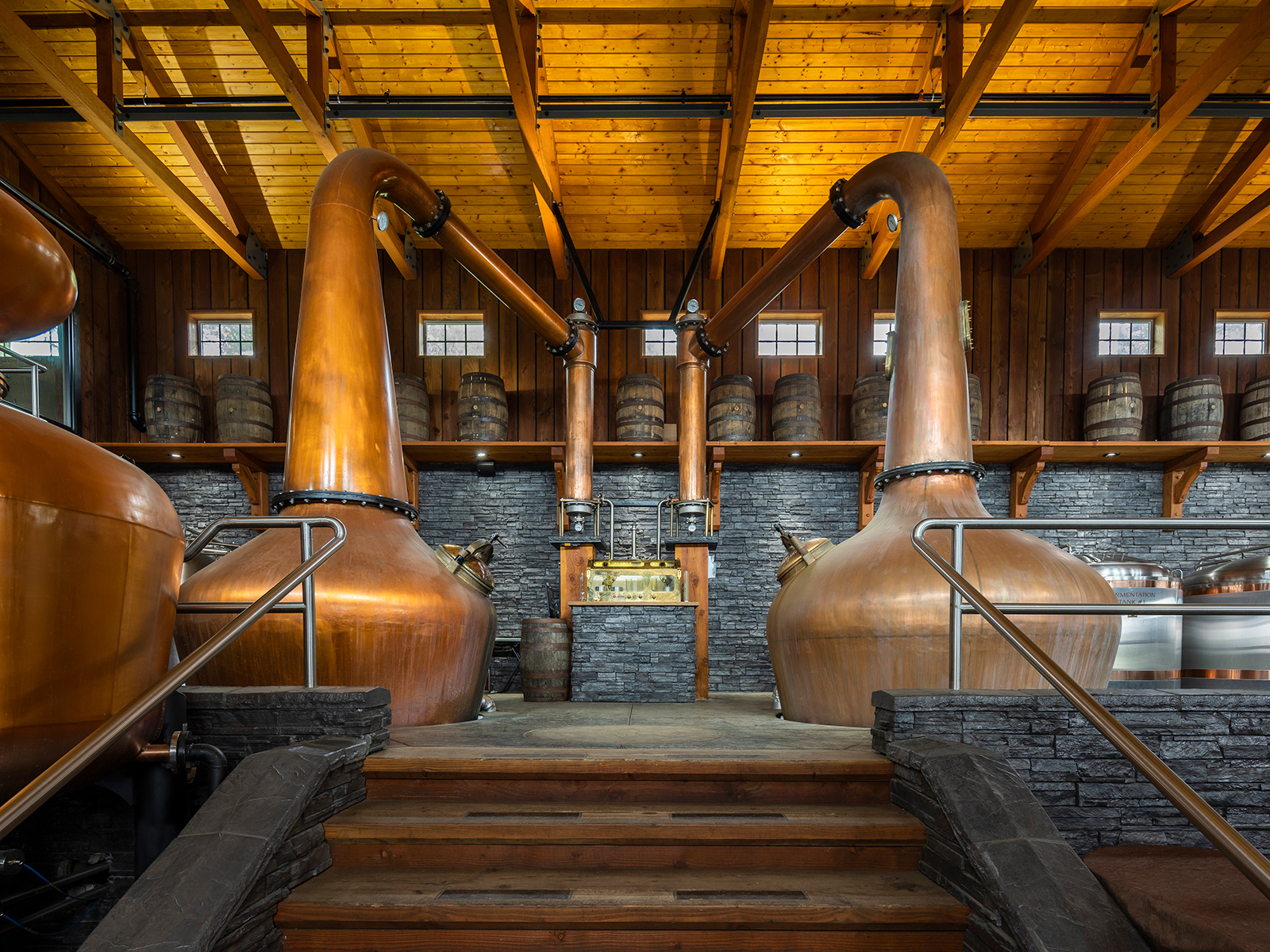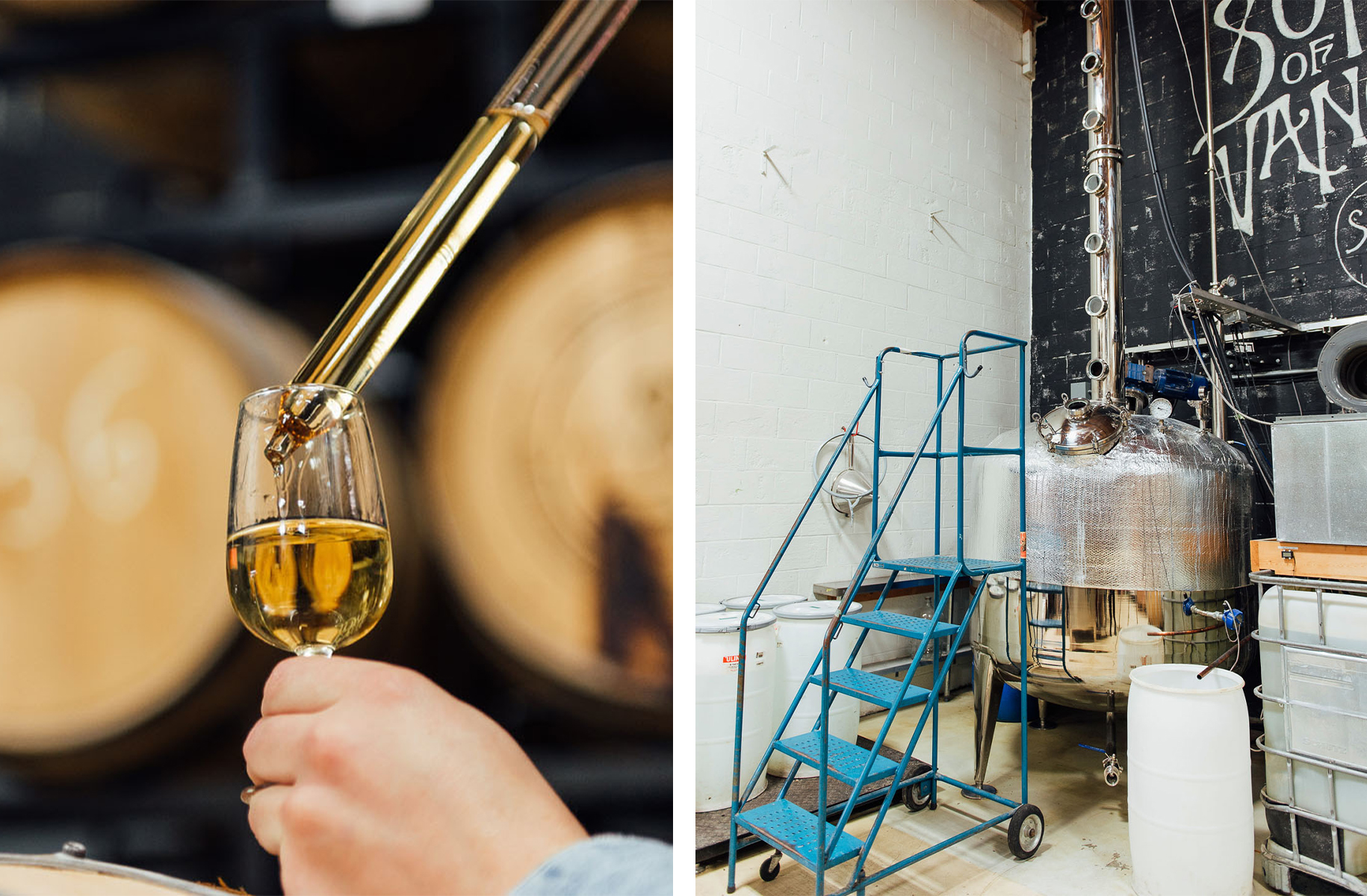As the doors of the warehouse clatter open at Shelter Point Distillery, letting in the afternoon sunlight, the air from indoors and outdoors blends for a moment on the threshold. Outside, a breeze blows smoky salt air off the Strait of Georgia, settling in a haze over maples and firs on the treeline and carrying the sweet decomposition of barley stalks and a hint of precious rain after a dry summer. On the horizon, lazy fishing boats wait for the pink salmon rushing shoreward to struggle their way up the Oyster River.
The exhalation from inside the old barn, where the whisky is stored in racked columns four casks around and four high, is thick with the smell of earth, oak, and alcohol. Black resin oozes around and over the gently rusted hoops of the barrels, standing row on row back into the gloom—hundreds of thousands of litres of aging spirit—labelled in the sequence in which they were filled but arranged in an order mysterious to all but the blenders: 662, 206, 713…
Somewhere hidden in this cavern is barrel number three, whisky poured into oak from the first runnings of Shelter Point’s stills in 2011 (barrels one and two were used up long ago, to some later regret). The 12-year-old whisky—some of the oldest spirit in British Columbia still resting in a barrel—has silently witnessed a transformative decade for the province’s distilling industry. When that original barrel was only two years old, B.C.’s deputy premier announced an epochal shift to liquor regulations, allowing small-scale distillers who use all-local materials to sell directly to consumers without onerous—in his words “daft”—rules, including a 160 per cent markup. A year later, the first BC Distilled craft liquor conference hosted 17 distilleries in Vancouver’s CBC building—although so few produced whisky there was no use picking an audience favourite. When the barrel turned six, new distilleries were opening up from North Vancouver to the Cowichan Valley to the Monashees, laying down whisky that would go on to shatter expectations in a national blind tasting. This year, as barrel number three forges into its second decade, 39 craft producers at BC Distilled served 185 locally made liquors, including 35 whiskies.
B.C. whisky is coming of age. A decade after the launch of the province’s craft designation, distilleries have had the time to build their stills, float through early years bottling gin, vodka, and liqueurs, and wait the three years minimum that spirit must age in a barrel before it can be called Canadian whisky. But the local renaissance is not just about the age of the casks, says Canadian whisky expert and author Davin de Kergommeaux. It’s also about the industry’s depth of skill, experience, and sophistication. “Age doesn’t give you great whisky; it gives you something to work with. Intelligence makes great whisky,” he says. “Now we have some wonderful whisky coming out of British Columbia. People are really learning, and the distillers are more educated—they’ve learned by doing and learned by making mistakes. At the beginning they were drinkable, but they were nothing to rave about. Now they are at an international level.”

Photo courtesy of Shelter Point Distillery.
The vaulted still room at Shelter Point near Campbell River is a cathedral to the traditionalist approach to B.C. whisky. At the centre of 380 acres of agricultural land, the distillery hews close to nature, the earth, and traditional Scottish methods. A row of gleaming fermentation tanks, each filled weekly with the wort from a ton of grain from the surrounding fields, leads up to the two towering copper pot stills, the brass fittings stamped by Forsyths, supplier to many of the great scotch houses.
Heat and the overpowering sweet smell of malted barley radiate from one still while fermented mash bubbles through a window in the slender neck. James Marinus, Shelter Point’s head distiller, manages a delicate stream of distilled liquor that trickles from a faucet as his shaggy golden Labrador mauls a stick on the spotless stone floor. Lanky and agile in a faded Woodford Reserve T-shirt, Marinus samples the transparent stream and consults a digital screen before flicking the faucet across from one tank to another, making the cut between the unpleasant head vapours and the pleasant-tasting hearts.
“You’ve got to rely on your senses,” Marinus says. “Cut a little earlier, cut a little later. Usually, you make the head cut at 25 minutes, but as you’re nosing through it, maybe 26 minutes is going to be better.” He smiles wryly and shrugs.
Marinus’s work is to build a palette of flavours—some cleaner, some bolder, some sweeter, some smoother—that can be blended years from now to create the distinctive whole of Shelter Point’s whiskies, such as the bold and warm Single Malt or the oaky and smooth Ripple Rock. Most of that work happens through time, and subtle differences in wood, temperature, and spirit chemistry. “I can make good clean spirit today and throw it in 10 different barrels, identical, and come back 10 years and taste them all, and they’ll all be different,” he says.
Plenty sets Shelter Point apart from other B.C. craft distilleries, including deep-pocketed investment that allowed Marinus to stock a sizable warehouse for five years before releasing a drop to the public. But above all, what distinguishes the whisky is its consistency and dedication to straightforward craftsmanship—a level-headed approach that has resulted in growing recognition, including two gold medals at the San Francisco World Spirits Competition and the prestigious Scotch Malt Whisky Society’s first selection from Canada.
The opposite approach can be found in a North Vancouver light-industrial strip, surrounded by repair shops, the entrance almost obscured by an oak tree. Sons of Vancouver is a young distillery, producing its first spirits in 2015—whimsical bottles such as a Cheetos-orange-coloured chili vodka and a whisky aptly titled Cigarettes on a Leather Jacket. But the distillery’s rise to fame stems from a Canadian Bottle Shock moment early this year that disrupted 13 years of dominance by large whisky brands. In January, Sons of Vancouver’s Palm Trees and a Tropical Breeze rye won whisky of the year at the Canadian Whisky Awards in a blind tasting, a title small distilleries had always lost to the likes of Crown Royal or a 43-year-old Canadian Club.
“The one thing we have as a small distillery is time. We can do longer fermentations. We can experiment with different things.” —Jenna Diubaldo
“We were blown away,” says Jenna Diubaldo, Sons of Vancouver’s production manager. Inside the crowded cube in which she ferments, distills, and bottles, she is tending to a twitching tube as it pumps 100 per cent rye into a used Islay cask. “We weren’t even there,” she says. “Then we got this barrage of texts, and we were like, is this a joke?”
If overcoming the Goliaths wasn’t enough, Palm Trees was only three years old. Diubaldo says Sons sped up maturation by blending and switching the aging spirit between four casks, giving it the opportunity to pick up a depth of flavour that might take a conventional whisky years longer. This is the playful approach Sons takes to distilling—using French beer yeasts to produce flavours of spice and fruit, or saving precious space by retrofitting their mash tun to work dual purpose as both a fermenter and makeshift still.
“The one thing we have as a small distillery is time,” Diubaldo says. “We can do longer fermentations. We can experiment with different things.”
If Shelter Point reflects the time-honoured distilling culture of Scotland, Sons of Vancouver draws its inspiration from the rough-and-tumble West Coast craft beer scene. Diubaldo, as well as both Sons founders, James Lester and Richard Klaus (who has since left the distillery), have beer-brewing backgrounds. Diubaldo, a talented newcomer who joined the distillery in 2021, is charged with expanding whisky production to meet the new demand. The Palm Trees award left the distillery a victim of its own success, she says, with customers clamouring for a small-batch whisky that had long since sold out. Nevertheless, she’s happy with Sons of Vancouver’s rebel status.
“We’re trying not to taste like everything out there,” she says. “We’re not unaware of this reputation that follows around Canadian whisky, that it’s this smooth, single-note thing. We really want to make a name for ourselves with something flavourful and unique.”

Photos courtesy of Sons of Vancouver.
Though B.C.’s whisky culture is too young and raucous to have developed a cohesive style of its own, what local distillers share are limitations. To qualify as craft, distillers must use only B.C. products to ferment their alcohol, which means relying on a few barley growers and even fewer malting houses. The peat-smoked malt that gives many Scotch whiskies their distinctive aroma is nowhere to be found—a puzzle local distillers have tackled by pumping smoke into barrels, aging whisky in casks that once held peaty Scotch, or cutting their own peat from West Coast bogs.
Nowhere has the problem been skirted more inventively than by Gordon Glanz, whose eyes twinkle with excitement as he shows off the invention that helped him solve the peat problem. Glanz’s Odd Society fits into a narrow slot of a building on Powell Street in East Vancouver, and the machinery of the distillery is laid out with a blend of clockwork precision and mad-scientist abandon. Behind the alchemically beautiful copper stills—scavenged from a defunct distillery in Switzerland—a stainless steel cylinder hangs between connecting pipes like a set of lungs. This, Glanz explains, is a gin basket, a chamber through which vapourized liquor is passed to absorb the delicate aromas of citrus or botanicals. By packing the basket with imported German smoked malt, he produces peaty whiskies such as his subtle Smoke & Oak Rauch Malt while never mashing in a foreign product.
Ideas like this tumble from Glanz compulsively and express themselves in the array of small-batch whiskies he’s produced—distilled from hopped beer and fermented sour cherries, aged in maple-syrup barrels, or infused with foraged mushrooms. His newest release, commemorating 10 years of operation, contains a splash of every whisky he’s ever distilled.
But with a maturing whisky collection, Odd Society is also moving slowly in the direction of Shelter Point—producing consistent, larger-batch house whiskies that can fill liquor store shelves and build a brand with bartenders. It’s a prospect Glanz embraces while still believing B.C. whisky should blaze its own path.
“I feel like we have to do something different,” he says. “We’re not in Scotland. We can learn from Scotland—they make phenomenal whiskies. But if someone wants a Scotch whisky, they can buy a 10-year-old scotch for the same amount of money. That’s why we’re just trying to find a different voice.”
Read more from our Winter 2023 issue.









